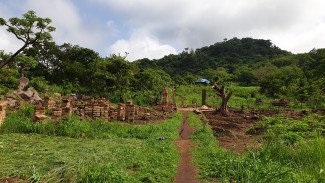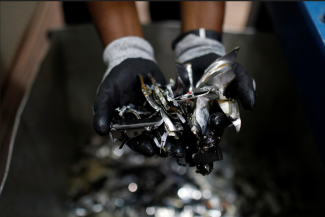Cambodia is the voice of the 47 Least Developed Countries (LDCs) at the World Trade Organization (WTO)
The year is 2017 and Cambodia has stepped into a role that has been out of its reach for years — the voice of 47 Least Developed Countries (LDCs) at the Word Trade Organization. They’re the talk of the town — with a visionary trade policy and the trust and support of a group of donor partners that has helped them achieve an annual economic growth rate that many countries would dream about.
“Cambodia’s cross sectoral trade policy has been very famous in the LDC constituency. Many countries want to come to Cambodia to learn about it,” says Hang Tran, a senior coordinator at the Executive Secretariat for the Enhanced Integrated Framework (EIF), a programme that has supported Cambodia to not only handle its WTO commitments but has also helped build the country’s capacity to formulate and implement its trade policy.
To understand Cambodia’s remarkable trade journey, we need to go back to 2007, the year Cambodia ran its second Diagnostic Trade Integration Study (DTIS). Traditionally, these EIF studies are comprehensive macroeconomic portraits that identify constraints and opportunities to a country’s ability to export its goods and services to regional and international markets.
“Essentially you have a checklist that helps you diagnose the situation to determine a country's strengths, weakness, threats and opportunities to trade.” says Tran.
This analytical work helps to identify priority actions to be taken by relevant stakeholders in the country. But, Cambodia did not follow this traditional approach, Tran says.
“The difference with Cambodia is that the DTIS led to a comprehensive National Trade Strategy aligned with the government's vision for sustainable development. It focused on how to realise this vision using trade as engine for growth across sectors,” Tran says.
So, at the end of the 2007 Diagnostic Trade Integration Study, the government launched what was to become the backbone for an ambitious cross cutting trade strategy — the Trade Sector Wide Approach, or Trade SWAp.
TAKING AN INTEGRATED APPROACH TO TRADE
The Trade SWAp is based on three pillars:
- Reforms and cross-cutting issues for trade development (legal reforms, trade facilitation, technical barriers to trade, improving sanitary and phyto-sanitary regulation and practice);
- Product and service sector export development (sector-specific reforms, with a focus on the products identified in the DTIS 2007); and
- Capacity-building for trade development and for the management of trade development (building competencies, institutional functionality, and information and accountability systems).
The approach has allowed for, what seem to be, unrelated projects to contribute to a common development goal, says Kamrang Tekreth, Secretary of State at Cambodia’s Ministry of Commerce.
“Trade is a cross cutting issue. The Ministry of Commerce cannot do it alone. The Ministry of Industry and Handicrafts has been responsible for standardisation of the products. The Ministry of Agriculture, Forestry and Fishery is responsible for increasing supply production. The Ministry of Economics and Finance through the customs agency are working on trade facilitation and import/export,” says Tekreth, who has played a central role in developing the Trade SWAp.
“The Trade SWAp has helped us provide a way for all stakeholders to come together and discuss to identify challenges and opportunities that trade can provide. Because we have the same goals — growth of trade, improving living standards, promoting and increasing exports — it has helped us to motivate each other.”
During the implementation of projects, meetings organized in the framework of the Trade SWAp, namely monthly meetings of the SWAp Implementation Committee, quarterly meetings of the Sub-Steering Committee on Trade Development and Trade-Related Investment (SSC TDTRI) and regular SWAp Pillar Working Groups are all coordinated by Ministry of Commerce.
Accordingly, every four months the Ministry also organized an informal meeting on trade development update with in-country development partners. The purpose of the meeting was to update trade support activities from each Partner who was supporting trade development in Cambodia, says Tekreth.
The cross-sectoral approach has also made it easier to coordinate project resourcing, says Tran.
“Some partners prefer to support sectors which have high visibility. So the sectors with a low visibility but high importance for the country may be under-resourced,” she says.
“Through Trade SWAp and a multi-donor trust fund, the government was able to channel aid for trade resources in areas that the government might normally struggle to resource, such as institutional capacity-building. They managed to get the resources they needed across the board.”
LEARNING BY DOING
A key part of the EIF approach has been increasing institutional capacity, and again it was done in a unique way, says Tran.
“Instead of creating a project implementation unit with outside staff, the Ministry of Commerce created a permanent institution in the form of the Department of International Cooperation (DICO) as the main project implementing entity. They developed the project, they submit it to us and they lead the implementation of the project but can call on us for support,” Tran says.
“Five years down the road you can see the difference — they have confidence to manage projects and you can see they are doing well — they have started by managing US$1.5 million in projects and they are now managing a US$36.3 million loan. That is the indication of institutional capacity.”
“If you don’t enable people to learn by doing and to make mistakes, then they won’t grow.”
Tekreth has found this approach refreshing.
“Before the staff didn’t know much about HR, finance, monitoring and evaluation but by doing the project implementation and receiving specialised short- and long-term training, we feel very strong in our capacity,” she says.
“Even me, I learnt from all that ongoing technical and financial support.”
Mr Suon Prasith, Deputy Director General at the General Department of International Trade in the Ministry of Commerce, confirmed: ''Through the EIF, Cambodia implements aid for trade effectively and took ownership seriously."
RICE AND SILK
A testament to a well-implemented set of programs, most of the 10 sectors that were identified for increased supply have performed very well over the past decade, Tekreth says.
The high value silk project, which has been supported by the EIF, has seen a 74% increase in export of Cambodian silk and exports reached five selected import markets: the EU, the USA, Japan, Australia and New Zealand. Over 160 new weavers have been employed and nearly 130 new silk product designs developed, showing Cambodia can not only compete not only on price but also on quality.
“The weavers, most of whom are women, tell us that they have doubled their monthly income. We are happy that this project can promote women’s economic empowerment, especially in rural areas, which is one of our main agendas,”Tekreth says.
Rice, the largest employment sector of the Cambodian economy, has experienced similar gains. Since 2011, Cambodian rice exports increased threefold. Cambodian rice now meets standard and hygiene requirements for export to most international markets.
“Cambodian rice received the World's Best Rice Award three years in a row (from 2012 to 2014), and have never been outside the top three ever since. It is a testimony to standard of rice that we are producing,” Tekreth says.
ENSURING SUSTAINABILITY
With most of the sectoral projects and the Least Developed Countries group coordination role coming to a close at the end of 2017, Cambodia is now focusing on ensuring the strong institutions that have been built can sustain the gains achieved over the past decade.
Tekreth sees the committee developed at both a national level, and within sectors as integral to this.
“We have developed strategies to solve problems fast and work closely with the private sector. It has not been without challenges but we have overcome the challenges together,” she says.
With Cambodia’s next Diagnostic Trade Integration Study update set to occur in 2018, all eyes will be on where the country’s famous cross sectoral economic vision goes next.
Header image of a green power project bringing electricity to the rural poor in Bhutan - ©Asian Development Bank via Flickr Creative Commons Attribution-NonCommercial-NoDerivs 2.0 Generic (CC BY-NC-ND 2.0) license.
If you would like to reuse any material published here, please let us know by sending an email to EIF Communications: eifcommunications@wto.org.



